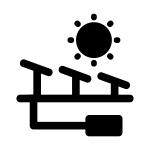Safe water solutions for the hundreds of people living in Nzimba seem plentiful since there are two sand dams with shallow wells in their community, but for those not living near the water points, collecting enough water each day kilometers away is still overwhelming.
The community made significant contributions implementing the two projects in 2020 and 2021, thinking their lives would be better. And while this is true for those living near the water points, those who live kilometers away still suffer.
"Although there is enough water for residents who live nearby, those who live far away have to cover more than a kilometer to arrive at this water point," said 70-year-old farmer Edward Mutiso (shown below).

"With my old age, coming here to fetch water is a dreary affair because of the steep hill, long distance, and scorching sun," said Edward.
To avoid the heat while trekking across steep hills to the nearest well, those who live farthest must wake up very early each morning for the two-hour round trip. The long journey leaves them exhausted, making it difficult to have any energy for other responsibilities once they return home. As a result, things like farming, caring for livestock, and personal hygiene suffer.
"This region has a lot of steep hills, and getting livestock to come and drink water here is exhausting and time-consuming," said 15-year-old Nyamai M., in the photo below.

"I only manage to carry some water for drinking and cooking at home, which negatively affects my personal hygiene."
With a solar kiosk that will strengthen the water infrastructure in Nzimba and bring water closer to Edward and Nyamai's homes, they can reserve their time and energy to accomplish other important tasks.
What We Can Do:
Our main entry point into this community has been the local Self-Help Group, which comprises households working together to address water and food scarcity in their region. These members will be our hands and feet in constructing water projects and spreading the message of good hygiene and sanitation to everyone.
Solar Water Distribution
This solar water distribution project will be built adjacent to one of our completed sand dam projects, which supplies clean drinking water to multiple surrounding communities. Given that the water source is still kilometers away from the farthest households, the solar distribution project will bring clean water closer to families who need it.
Solar-powered water distribution projects use solar energy to pump water from sand dams to elevated locations within villages to enable further water distribution and access within the communities. The water is pumped to storage tanks at an elevated platform and then connected to a water kiosk, where the water is collected from taps.
Hygiene and Sanitation Knowledge
As we have worked with this Self-Help Group already, we will hold refresher hygiene and sanitation training sessions to address essential hygiene practices and daily habits that need improvement. This training will help to ensure that participants have the knowledge they need to make the most out of their new water point as soon as the water is flowing.
One of the most important topics we plan to cover is handling, storage, and water treatment. Having a clean water source will be extremely helpful, but it is useless if water gets contaminated when it is consumed. We will also emphasize the importance of handwashing.
We typically work with self-help groups for 3 to 5 years on multiple water projects. We will conduct follow-up visits and refresher training during this period and remain in contact with the group after all of the projects are completed to support their efforts to improve sanitation and hygiene.
All of these components will work together to improve living standards here, which will help to unlock the potential for these community members to live better, healthier lives.

 Solar Pump
Solar Pump
 Rehabilitation Project
Rehabilitation Project













 We worked with the Kasilu Self-Help Group for this project. The members and their families contributed tremendous amounts of materials and an extraordinary amount of physical labor.
We worked with the Kasilu Self-Help Group for this project. The members and their families contributed tremendous amounts of materials and an extraordinary amount of physical labor.















